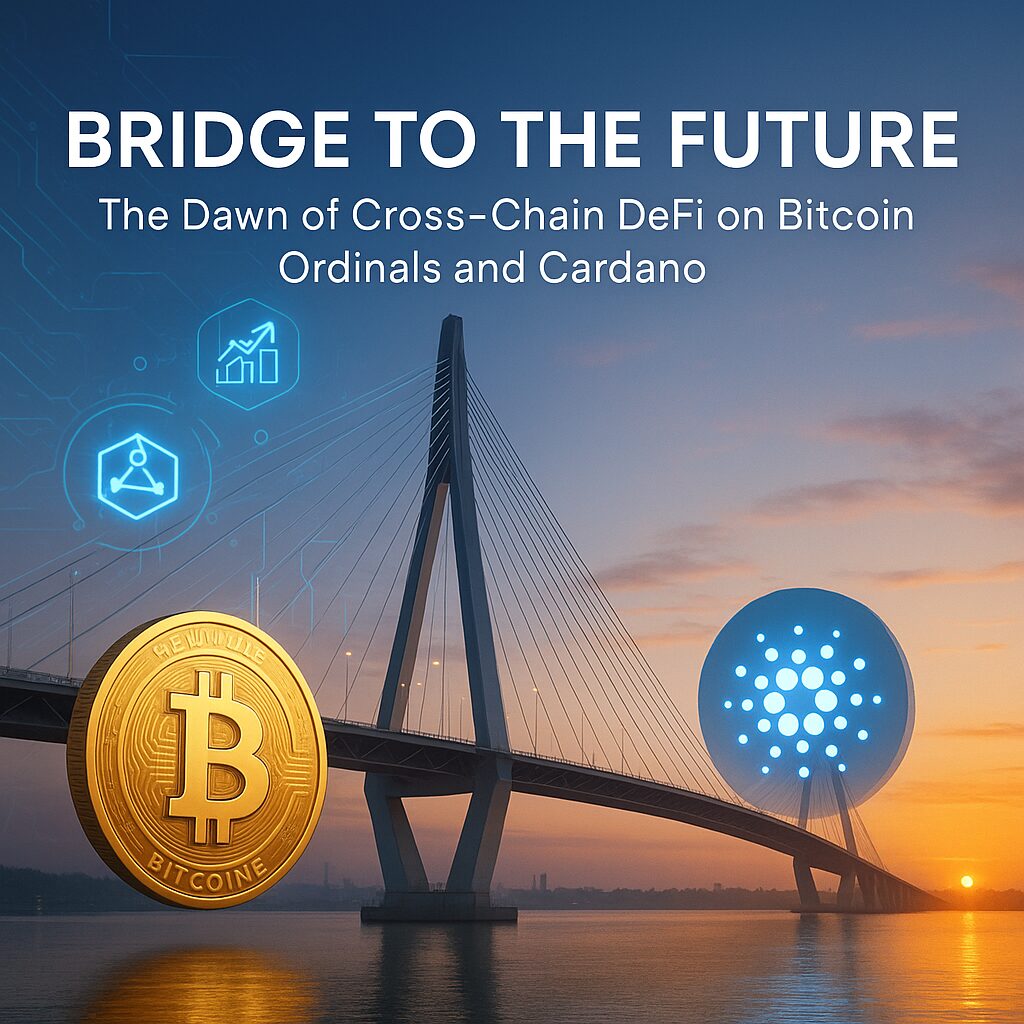
Main Points:
- Cardano now supports the bridging of Bitcoin Ordinals via the BitVMX interoperability protocol.
- The “Cardinal” protocol leverages BitVMX to wrap and assign Bitcoin-native assets on the Cardano network.
- This milestone unlocks an estimated $1.5 trillion in DeFi liquidity for BTC holders.
- Comparison with existing bridges such as RenVM and LayerZero’s Stargate highlights Cardinal’s trust-minimized design.
- Ongoing innovations—like the ESSPI signature scheme—promise greater efficiency and scalability for BitVMX.
- Ecosystem integrations (Lace Wallet, Brave) and strategic alliances (Fairgate, Rootstock Labs) pave the way for full BTC-ADA integration.
1. Introduction
In late May 2025, Input | Output (IO), the research arm behind Cardano, showcased a landmark achievement: the first-ever on-chain transfer of Bitcoin Ordinals to the Cardano mainnet. Using the BitVMX protocol, this demonstration at the Bitcoin 2025 conference in Las Vegas underscores Cardano’s evolution as a premier venue for Bitcoin-centric DeFi (“BTCFi”) and signals the beginning of genuine, trust-minimized cross-chain interoperability.
2. Background: Ordinals and Bitcoin DeFi
The Ordinals protocol—introduced in early 2023—assigns unique data inscriptions to individual satoshis, effectively creating Bitcoin’s version of NFTs. By making satoshis traceable and programmable, Ordinals opened new avenues for on-chain collectibles, art, and tokenization directly on Bitcoin. However, until now, Ordinals remained confined to the Bitcoin network, limiting their composability with advanced DeFi primitives found on smart-contract platforms.
3. BitVMX and the Cardinal Protocol
BitVMX is an interoperability framework built atop BitVM, a Bitcoin virtual machine that enables off-chain computation with on-chain verification. BitVMX uses a network of honest operators to process complex computations—such as wrapping an Ordinal—off-chain, then settle results on both blockchains. IO harnesses BitVMX in its “Cardinal” protocol (a portmanteau of Cardano and Ordinals) to lock Bitcoin assets and mint corresponding tokens on Cardano addresses, preserving 1:1 backing without centralized custodians.
4. Historic Bridge: First Ordinals Transfer
On May 27, 2025, at the Bitcoin 2025 conference, IO unveiled the first live transfer: an Ordinal inscription moved from Bitcoin into a wrapped Cardano asset via BitVMX. Attendees witnessed the trust-minimized bridge execute with on-chain settlement on both networks, a proof-of-concept that Cardano can act as a secure DeFi layer for Bitcoin value. IO called this “a preview of what is to come” and emphasized the goal of full BTC-ADA integration for seamless asset movement.
5. Market Impact: Unlocking Trillions in Liquidity
By bridging Bitcoin’s store of value to Cardano’s DeFi ecosystem, Cardinal taps into an estimated $1.5 trillion of dormant liquidity locked in BTC. This influx can power lending protocols, leveraged trading, NFT-collateralized loans, and automated market-making on Cardano. Charles Hoskinson, IO’s CEO, noted that enabling Bitcoin holders to deploy assets across diverse financial instruments without surrendering sovereignty marks a new era of decentralized finance.
6. Competitive Landscape: RenVM, LayerZero, and Beyond
Cardinal joins a growing roster of cross-chain bridges:
- RenVM, which mints renBTC (an ERC-20 representation of BTC) to access Ethereum DeFi, has secured over $750 million in wrapped BTC collateral across Ethereum and Binance Smart Chain.
- LayerZero’s Stargate leverages omnichain messaging to deliver unified liquidity and instant finality for assets like ETH, USDC, and CAKE across multiple EVM-compatible chains.
- Future LayerZero integrations—such as a planned connection to Bitcoin sidechain Rootstock—highlight the sector’s push for broader interoperability.
Unlike many existing bridges that rely on multi-signature custodians or wrapped tokens, Cardinal’s BitVMX approach is inherently trust-minimized, using cryptographic proofs and economic incentives to ensure secure atomic swaps.
7. Technical Innovations: ESSPI and Enhanced BitVMX
While BitVMX’s initial implementation used one-time signature schemes (e.g., Winternitz OTS), a recent arXiv paper—ESSPI—proposes leveraging Schnorr signatures to reduce data overhead from 1:200 to 1:1 expansion. ESSPI introduces:
- A challengeable hashing core in the BitVMX CPU.
- Partition-based fraud detection during hashing.
- A transaction DAG with fraud-verifying smart contracts.
- A timelock-based proof of data availability.
Integrating ESSPI could dramatically lower on-chain footprint and gas costs, enhancing BitVMX’s scalability for routine DeFi operations.
8. Ecosystem Integrations: Wallets and Partnerships
To ensure broad user adoption, IO and partners are embedding Cardinal support across wallets and platforms:
- Lace Wallet will allow users to bridge BTC assets and pay fees directly in BTC.
- Brave is exploring integration to bring Cardano’s DeFi dApps to its browser ecosystem.
- The BitVMX Alliance—a consortium including Fairgate, Rootstock Labs, and IO—seeks to standardize trust-minimized interoperability across chains.
These collaborations will simplify the user experience, reducing friction for newcomers and institutional participants alike.
9. Future Developments: Full BTC-ADA Integration
IO’s roadmap extends beyond NFT-style asset wrapping. Upcoming phases include:
- Two-way wrapped BTC, enabling Cardano users to return tokens to BTC on demand.
- Native DeFi primitives—lending pools, synthetic assets, and decentralized exchanges—secured by Bitcoin’s hash power.
- Cross-chain governance, allowing BTC and ADA stakeholders to propose and vote on protocol upgrades.
Together, these steps aim to blur the boundaries between Bitcoin’s security and Cardano’s programmability, creating a unified, cross-chain financial landscape.
10. Conclusion
The successful bridging of Ordinals to Cardano via BitVMX represents a watershed moment for blockchain interoperability. By unlocking trillions in Bitcoin liquidity and offering a truly trust-minimized DeFi layer, Cardinal paves the way for a new era in which assets freely traverse networks without sacrificing security or sovereignty. As technical optimizations like ESSPI roll out and wallet integrations mature, the convergence of Bitcoin and Cardano ecosystems will redefine decentralized finance, empowering users with unprecedented choice and control.

